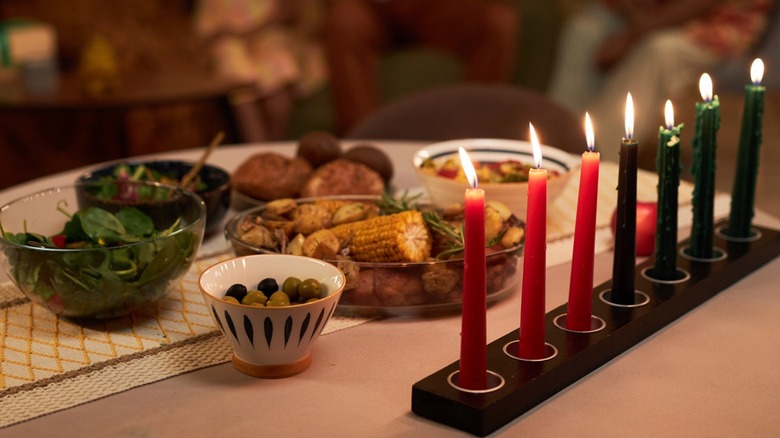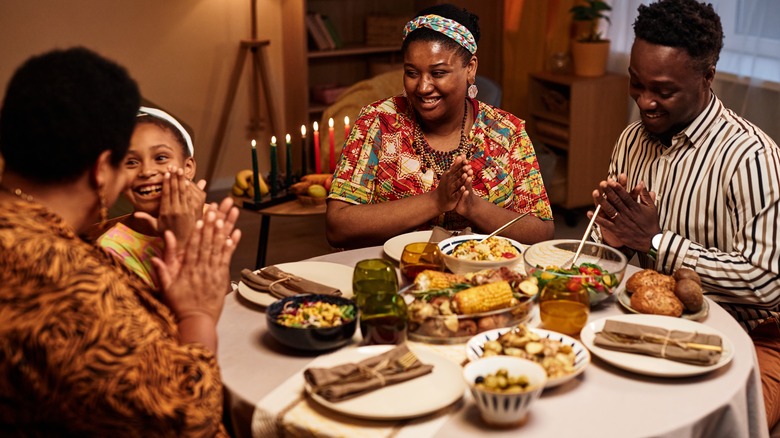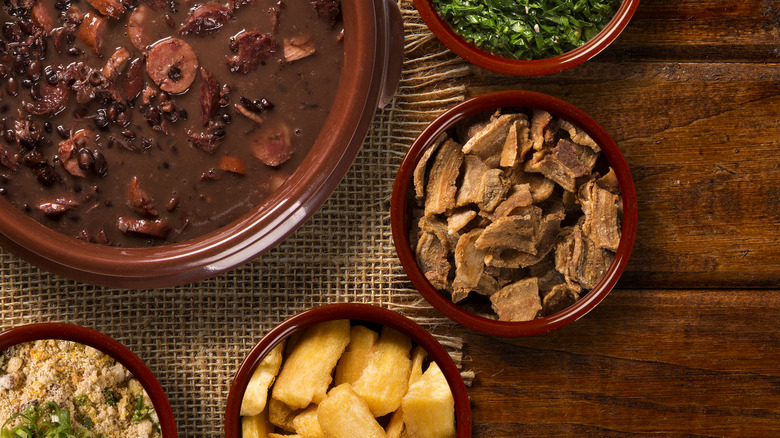Why Kwanzaa Feasts Draw On So Many Different Cuisines To Set The Table
Kwanzaa is observed from December 26 to January 1, culminating in feasting and gift-giving. Focused on cultural values and principles, it is a time for African Americans and members of the Black African diaspora to celebrate their heritage and reinforce family and community bonds. While it isn't a religious holiday, it does occur around the same time as Christmas and Hanukkah. Like any good winter holiday, Kwanzaa is all about food. However, Kwanzaa doesn't subscribe to any one menu or cuisine.
Because the African diaspora spans so many nations, cultures, and cuisines, the menu isn't to any one heritage. While Kwanzaa was established in 1966 to unite African Americans specifically, we know that due to the slave trade, the diaspora spans many nations. Soul food from America's South is a common part of a Kwanzaa feast, but so are dishes from West, South, and East Africa, as well as Afro-Caribbean and Afro-Latinx nations. Food is of particular significance to the holiday because, as cookbook author, journalist, and recipient of the James Beard Lifetime Achievement Award, Jessica B. Harris says, "Your history is on the plate. Food is identity" (via James Beard Foundation). While there are no hard rules for what to serve, here are a few of the dishes you may find at a Kwanzaa feast.
Soul food across nations
Since Kwanzaa started as and remains a holiday primarily celebrated by African Americans, let's talk Southern American food. Black-eyed peas and collard greens are big parts of Southern soul food any day of the year but are eaten at Kwanzaa to welcome good luck and fortune, respectively. Candied yams, macaroni and cheese, and cornbread also frequently appear on the table.
Since Kwanzaa is just as much about looking back to heritage and ancestry, traditional African cuisine certainly makes an appearance. Much of the diaspora's ancestry can be traced back to West Africa, and many of this region's dishes are served as well. Jollof rice is a common Kwanzaa dish and is popularly eaten throughout West Africa, most notably in Nigeria and Ghana. It consists of rice, onions, and tomatoes and is sometimes paired with either chicken or fried plantains. You may also see West African groundnut stew (also known as peanut stew or peanut butter soup), a puréed creamy, lightly sweet, tangy, and spicy dish often served over rice with chicken or fish. A Senegalese fish and rice dish called thieboudienne is also a welcome addition to the Kwanzaa feast.
Other typical Kwanzaa foods include injera, an Ethiopian flatbread; fufu, a common side dish served alongside Ghanaian meals consisting of boiled starch roots mashed into a dough ball; plantains; and other starchy delights such as fritters and other delicacies that bridge the gap between Africa and the diaspora.
Kwanzaa foods from the Caribbean and South America
Kwanzaa began as an African-American holiday, but the United States isn't the only place where the African diaspora lives. Many enslaved people were also brought to Brazil and the Caribbean, where their descendants still make up a significant part of the population. It only makes sense that these members of the diaspora would also want to celebrate and have their food celebrated during Kwanzaa. While these cuisines differ from traditional African and Southern American dishes, they still originate on the same continent and work beautifully alongside other Kwanzaa dishes. One thing to note is that these countries had pre-existing traditions of cooking with pork, unlike African nations, which focused more on chicken, beef, and fish. To celebrate heritage and both cultural and culinary fusion, consider adding a pork dish to the menu.
For example, take feijoada, a black bean and pork dish served with plantains, rice, fried cassava flour, and bacon. It's commonly considered Brazil's national dish, and the story around it is that it came from enslaved Africans on plantations who used discarded pork scraps to create the stew. Though this has been disputed, it remains the most popular origin story for the dish. Regardless, the African influence on Brazilian cuisine cannot be understated, making this dish a perfect symbol of that connection. Of course, jerk pork and chicken from the Caribbean are great additions to the Kwanzaa table, adding smokey spice and sweetness.


